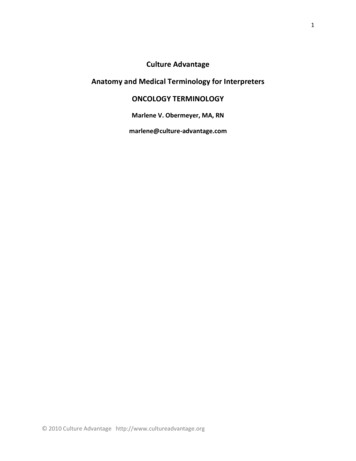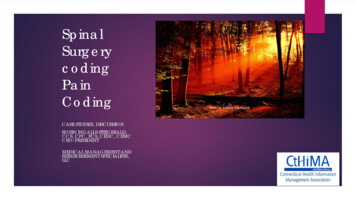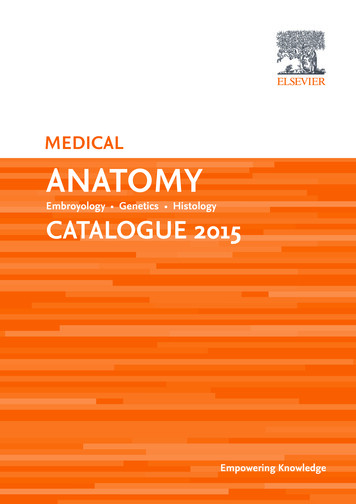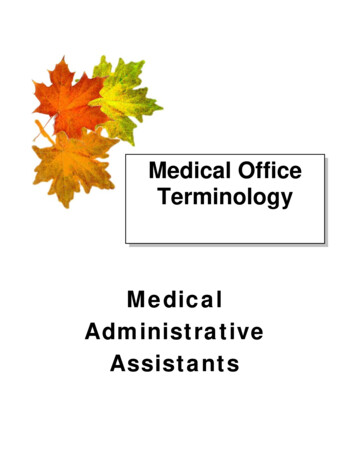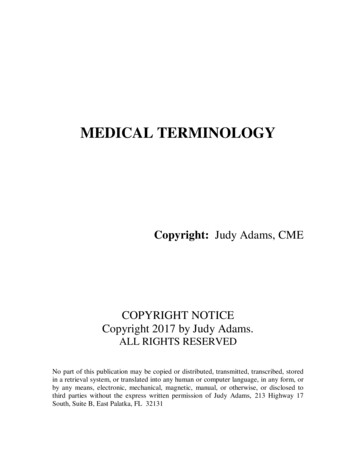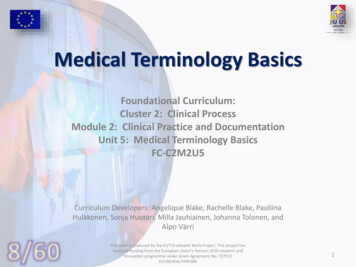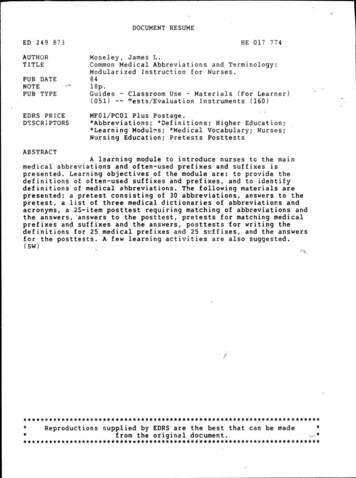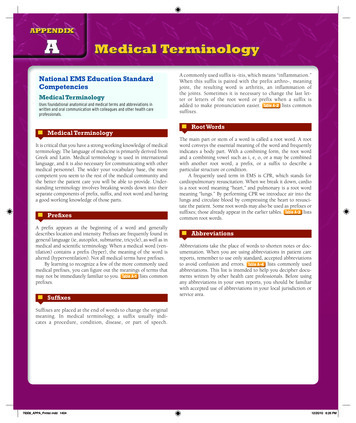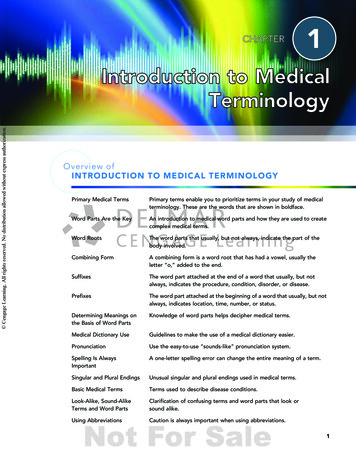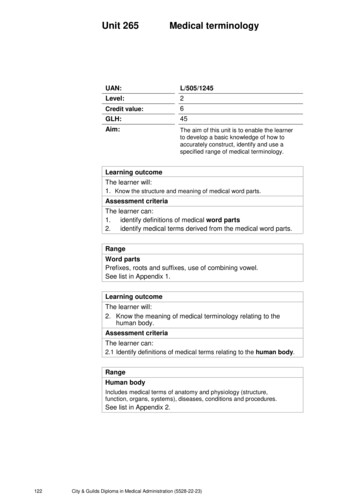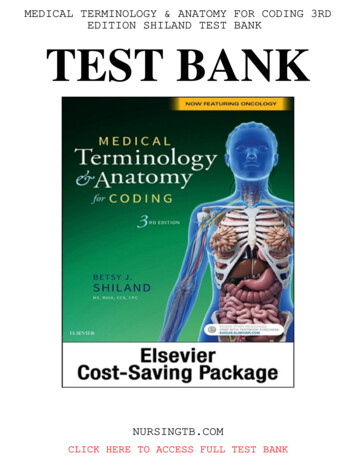
Transcription
MEDICAL TERMINOLOGY & ANATOMY FOR CODING 3RDEDITION SHILAND TEST BANKTEST BANKNURSINGTB.COMCLICK HERE TO ACCESS FULL TEST BANK
Medical Terminology & Anatomy for Coding 3rd Edition Shiland Test BankChapter 02-01: Body Structure and Directional TerminologyShiland: Medical Terminology and Anatomy for Coding, 3rd EditionMULTIPLE CHOICE1. The normal dynamic process of balance in the body isa. catabolism.b. anabolism.c. metabolism.d. homeostasis.ANS: DREF: p. 28OBJ: Recognize & Use Terms Associated with Organization of the BodyTOP: Word Parts & Translatable Terms2. The process of converting energy by breaking down substances isa. anabolism.b. catabolism.c. metabolism.d. homeostasis.ANS: BREF: p. 28OBJ: Recognize & Use Terms Associated with Organization of the BodyTOP: Word Parts & Translatable Terms3. The substance that holds organelles within a cell is thea. cytoplasm.NURSINGTB.COMb. lysosome.c. mitochondrion.d. ribosome.ANS: AREF: p. 28OBJ: Recognize & Use Terms Associated with Organization of the BodyTOP: Word Parts & Translatable Terms4. The structure that is the site of protein formation is thea. mitochondrion.b. ribosome.c. lysosome.d. nucleus.ANS: BREF: p. 28OBJ: Recognize & Use Terms Associated with Organization of the BodyTOP: Word Parts & Translatable Terms5. Which structure in a cell is responsible for conversion of nutrients to energy?a. Nucleusb. Mitochondrionc. Ribosomed. CytoplasmANS: BREF: p. 28NURSINGTB.COM
Medical Terminology & Anatomy for Coding 3rd Edition Shiland Test BankOBJ: Recognize & Use Terms Associated with Organization of the BodyTOP: Non-translatable Terms6. One of the combining forms for the nucleus of the cell isa. chondr/o.b. cyt/o.c. lys/o.d. kary/o.ANS: DREF: p. 33OBJ: Recognize & Use Terms Associated with Organization of the BodyTOP: Word Parts & Translatable Terms7. Tissue that has a supportive function in an organ or tissue isa. superficial.b. deep.c. stromal.d. parenchymal.ANS: CREF: p. 29OBJ: Recognize & Use Terms Associated with Organization of the BodyTOP: Non-translatable Terms8. Which type of tissue acts as an internal and external covering of the body?a. Epithelialb. Connectivec. Musculard. NervousNURSINGTB.COMANS: AREF: p. 29OBJ: Recognize & Use Terms Associated with Organization of the BodyTOP: Word Parts & Translatable Terms9. Bone, blood, and fat are examples of what type of tissue?a. Epithelialb. Connectivec. Musculard. NervousANS: BREF: p. 29OBJ: Recognize & Use Terms Associated with Organization of the BodyTOP: Non-translatable Terms10. Viscera is the healthcare term fora. cells.b. organs.c. tissues.d. body systems.ANS: BREF: p. 29OBJ: Recognize & Use Terms Associated with Organization of the BodyTOP: Word Parts & Translatable TermsNURSINGTB.COM
Medical Terminology & Anatomy for Coding 3rd Edition Shiland Test Bank11. Hist/o is a combining form fora. cell.b. organ.c. tissue.d. body system.ANS: CREF: p. 29OBJ: Recognize & Use Terms Associated with Organization of the BodyTOP: Word Parts & Translatable Terms12. The pointed extremity of a conical structure is considered thea. apex.b. fornix.c. antrum.d. body.ANS: AREF: p. 30OBJ: Recognize & Use Terms Associated with Organization of the BodyTOP: Non-translatable Terms13. An antrum is most similar to a(n)a. apex.b. fundus.c. hilum.d. sinus.ANS: DREF: p. 30OBJ: Recognize & Use Terms Associated with Organization of the BodyTOP: Non-translatable Terms NURSINGTB.COM14. The space within a tubelike structure is thea. sinus.b. lumen.c. hilum.d. vestibule.ANS: BREF: p. 30OBJ: Recognize & Use Terms Associated with Organization of the BodyTOP: Non-translatable Terms15. A small space at the beginning of a canal is thea. hilum.b. sinus.c. vestibule.d. fornix.ANS: CREF: p. 30OBJ: Recognize & Use Terms Associated with Organization of the BodyTOP: Non-translatable Terms16. What is the name of the organ part farthest from its opening?a. Fundusb. HilumNURSINGTB.COM
Medical Terminology & Anatomy for Coding 3rd Edition Shiland Test Bankc. Fornixd. ApexANS: AREF: p. 30OBJ: Recognize & Use Terms Associated with Organization of the BodyTOP: Non-translatable Terms17. What is the term for the area where nerves and vessels enter and exit an organ?a. Antrumb. Lumenc. Vestibuled. HilumANS: DREF: p. 30OBJ: Recognize & Use Terms Associated with Organization of the BodyTOP: Non-translatable Terms18. The largest or most important part of an organ is termed thea. body.b. lumen.c. apex.d. sinus.ANS: AREF: p. 30OBJ: Recognize & Use Terms Associated with Organization of the BodyTOP: Non-translatable Terms19. Crur/o is a combining form meaning theNURSINGTB.COMa. knee.b. back.c. abdomen.d. leg.ANS: DREF: p. 38OBJ: Recognize & Use Terms Associated with Organization of the BodyTOP: Word Parts & Translatable Terms20. Brachi/o is a combining form for thea. lung.b. arm.c. leg.d. neck.ANS: BREF: p. 37OBJ: Recognize & Use Terms Associated with Organization of the BodyTOP: Word Parts & Translatable Terms21. The sural area of the body refers to thea. head.b. chest.c. neck.d. calf.NURSINGTB.COM
Medical Terminology & Anatomy for Coding 3rd Edition Shiland Test BankANS: DREF: p. 39OBJ: Recognize & Use Terms Associated with Organization of the BodyTOP: Non-translatable Terms22. Cervic/o is a combining form for thea. abdomen.b. neck.c. chest.d. arm.ANS: BREF: p. 35OBJ: Recognize & Use Terms Associated with Organization of the BodyTOP: Word Parts & Translatable Terms23. Phren/o is a combining form meaninga. lungs.b. air.c. diaphragm.d. mind.ANS: CREF: p. 46OBJ: Recognize & Use Terms Associated with Organization of the BodyTOP: Word Parts & Translatable Terms24. Back to front isa. anteroposterior.b. posteroanterior.c. distoproximal.d. proximodistal.NURSINGTB.COMANS: BREF: p. 40TOP: Word Parts & Translatable TermsOBJ: Positional Directional25. Positioning a patient to examine the abdomen would be placing the person in a position.a. plantarb. proximalc. supined. proneANS: CREF: p. 43TOP: Non-translatable TermsOBJ: Positional Directional26. If a stroke on one side of the brain affects the opposite side, you would term its effect to be onthe side.a. anteriorb. posteriorc. contralaterald. ipsilateralANS: CREF: p. 42TOP: Word Parts & Translatable TermsOBJ: Positional Directional27. A patient with burns on her back has lesions on the aspect of her body.NURSINGTB.COM
Medical Terminology & Anatomy for Coding 3rd Edition Shiland Test Banka.b.c.d.anteriorventralposteriorproximalANS: CREF: p. 41TOP: Word Parts & Translatable TermsOBJ: Positional Directional28. When John grabbed the handle of a hot pan on his stove, he sustained burns on thesurface of his hand.a. superiorb. palmarc. plantard. pronateANS: BREF: p. 38TOP: Non-translatable TermsOBJ: Positional Directional29. Which term describes vessels that lead toward an organ?a. Afferentb. Efferentc. Mediald. LateralANS: AREF: p. 43TOP: Non-translatable TermsOBJ: Positional Directional30. The scrapes on the elbows of the child were described as injuries.NURSINGTB.COMa. supineb. superficialc. superiord. supinateANS: BREF: p. 42TOP: Non-translatable TermsOBJ: Positional Directional31. The part of the esophagus that is farthest from its beginning at the throat is the end.a. dorsalb. distalc. dextradd. proximalANS: BREF: p. 42TOP: Word Parts & Translatable TermsOBJ: Positional Directional32. A patient with a sinistrocardia has his heart located to the side of the body.a. frontb. backc. rightd. leftANS: DREF: p. 43TOP: Word Parts & Translatable TermsOBJ: Positional DirectionalNURSINGTB.COM
Medical Terminology & Anatomy for Coding 3rd Edition Shiland Test Bank33. A patient with bilateral pain hurts on of her body.a. one sideb. both sidesc. the frontd. the backANS: BREF: p. 42TOP: Word Parts & Translatable TermsOBJ: Positional Directional34. A patient lying in a prone position is lying on hera. belly.b. back.c. side.d. arm.ANS: AREF: p. 43TOP: Non-translatable TermsOBJ: Positional Directional35. One of the veterinarian’s canine patients had a bad flea bite that was caudal to his shoulders.The physician knew that it was toward hisa. belly.b. back.c. head.d. tail.ANS: DREF: p. 41TOP: Word Parts & Translatable TermsOBJ: Positional DirectionalNURSINGTB.COM36. When a patient came in with numbness of her left arm and left leg, the physician noted thatthe numbness was on the side.a. contralateralb. ipsilateralc. bilaterald. dextradANS: BREF: p. 41TOP: Word Parts & Translatable TermsOBJ: Positional Directional37. The abdominopelvic region that is immediately superior to the umbilical region is theregion.a. hypochondriacb. lumbarc. epigastricd. hypogastricANS: CREF: p. 47TOP: Word Parts & Translatable TermsOBJ: Abdominopelvic Quadrants & Regions38. The abdominopelvic region that is inferior to the left lumbar region is the left region.a. iliacb. hypogastricNURSINGTB.COM
Medical Terminology & Anatomy for Coding 3rd Edition Shiland Test Bankc. hypochondriacd. umbilicalANS: AREF: p. 47TOP: Word Parts & Translatable TermsOBJ: Abdominopelvic Quadrants & Regions39. The abdominopelvic region that is medial to the lumbar regions is the region.a. hypogastricb. epigastricc. umbilicald. hypochondriacANS: CREF: p. 47TOP: Word Parts & Translatable TermsOBJ: Abdominopelvic Quadrants & Regions40. Munro’s point is located in the quadrant.a. upper rightb. upper leftc. lower rightd. lower leftANS: DREF: p. 48TOP: Non-translatable TermsOBJ: Abdominopelvic Quadrants & Regions41. McBurney’s point is located in the quadrant.a. upper rightb. upper leftc. lower rightNURSINGTB.COMd. lower leftANS: CREF: p. 48TOP: Non-translatable TermsOBJ: Abdominopelvic Quadrants & Regions42. McBurney’s point is the area in one of the abdominopelvic quadrants wherea. if painful, it may indicate gallbladder disease.b. if painful, it may indicate appendicitis.c. surgeons introduce instruments to examine the mediastinum.d. surgeons introduce instruments to perform laparoscopic surgery.ANS: BREF: p. 48TOP: Non-translatable TermsOBJ: Abdominopelvic Quadrants & Regions43. The liver is in the quadrant.a. upper rightb. upper leftc. lower rightd. lower leftANS: AREF: p. 48TOP: Non-translatable TermsOBJ: Abdominopelvic Quadrants & Regions44. The stomach and spleen are located in the quadrant.a. upper rightNURSINGTB.COM
Medical Terminology & Anatomy for Coding 3rd Edition Shiland Test Bankb. upper leftc. lower rightd. lower leftANS: BREF: p. 48TOP: Non-translatable TermsOBJ: Abdominopelvic Quadrants & Regions45. The plane that separates the sides is the plane.a. coronalb. frontalc. transversed. sagittalANS: DREF: p. 49TOP: Word Parts & Translatable TermsOBJ: Planes46. The plane that divides the body into anterior and posterior sections is the plane.a. coronalb. frontalc. transversed. sagittale. Both A and BANS: EREF: p. 49TOP: Word Parts & Translatable TermsOBJ: Planes47. The plane separates the nose from the toes.a. frontalNURSINGTB.COMb. transversec. midsagittald. sagittalANS: BREF: p. 49OBJ: PlanesTOP: Non-translatable Terms48. The R in RUQ refers toa. rectum.b. required.c. retroperitoneal.d. right.ANS: DREF: pp. 48-49OBJ: Recognize & Use Terms Associated with Organization of the BodyTOP: Abbreviations49. A patient with a buildup of fatty deposits in the lining of the arteries has a problem with theof the arteries.a. hilumb. apexc. vestibuled. lumenANS: DREF: p. 30OBJ: Recognize & Use Terms Associated with Organization of the BodyNURSINGTB.COM
Medical Terminology & Anatomy for Coding 3rd Edition Shiland Test BankTOP: Non-translatable Terms50. The patient’s paranasal (cavities in bone) were inflamed.a. hilab. antrac. luminad. apicesANS: BREF: p. 30OBJ: Recognize & Use Terms Associated with Organization of the BodyTOP: Word Parts & Translatable Terms51. The x-rays showed a blunted (tip) of the right lung.a. apexb. fornixc. fundusd. bodyANS: AREF: p. 30OBJ: Recognize & Use Terms Associated with Organization of the BodyTOP: Non-translatable Terms52. An endotracheal tube is placed the trachea.a. aboveb. underc. withind. outsideANS: CREF: p.N33URSINGTB.COMOBJ: Recognize & Use Terms Associated with Organization of the BodyTOP: Word Parts & Translatable Terms53. Otoscopes are used for viewing thea. ears.b. eyes.c. bones.d. umbilical region.ANS: AREF: p. 36OBJ: Recognize & Use Terms Associated with Organization of the BodyTOP: Word Parts & Translatable Terms54. The combining form for the front isa. arthr/o.b. antr/o.c. anter/o.d. atri/o.ANS: CREF: p. 40TOP: Word Parts & Translatable TermsOBJ: Positional Directional55. Warts on the sole of a patient’s foot are described as being on the surface of the foot.a. inferiorNURSINGTB.COM
Medical Terminology & Anatomy for Coding 3rd Edition Shiland Test Bankb. superiorc. palmard. plantarANS: DREF: p. 38TOP: Non-translatable TermsOBJ: Positional Directional56. A dorsal cavity of the body is the cavity.a. cranialb. thoracicc. pelvicd. abdominalANS: AREF: p. 46TOP: Word Parts & Translatable TermsOBJ: Body Cavity57. An infection of the cavity is called peritonitis.a. cranialb. spinalc. thoracicd. abdominalANS: DREF: p. 46TOP: Word Parts & Translatable TermsOBJ: Body Cavity58. A patient came in with a mass of blood in the space between the lungs. That space is phragm.ANS: BNURSINGTB.COMREF: p. 46OBJ: Body Cavity TOP: Non-translatable Terms59. The pleura provides lubrication around thea. stomach.b. abdominal cavity.c. thoracic cavity.d. lungs.ANS: DREF: p. 46TOP: Word Parts & Translatable TermsOBJ: Body Cavity60. The bladder is located in the cavity.a. pelvicb. thoracicc. abdominald. cranialANS: AREF: p. 46TOP: Word Parts & Translatable TermsOBJ: Body Cavity61. The plane that separates the right and left lobes of the brain is the plane.NURSINGTB.COM
Medical Terminology & Anatomy for Coding 3rd Edition Shiland Test Banka.b.c.d.
Medical Terminology & Anatomy for Coding 3rd Edition Shiland Test Bank. N U R S I N G T B. C O M b. upper left c. lower right d. lower left ANS: B REF: p. 48 OBJ: Abdominopelvic Quadrants & Regions TOP: Non-translatable Terms 45. The plane that separates the sides is the _ plane. a. coronal b. frontal c. transverse d. sagittal ANS: D REF: p. 49 OBJ: Planes TOP: Word Parts & Translatable .
